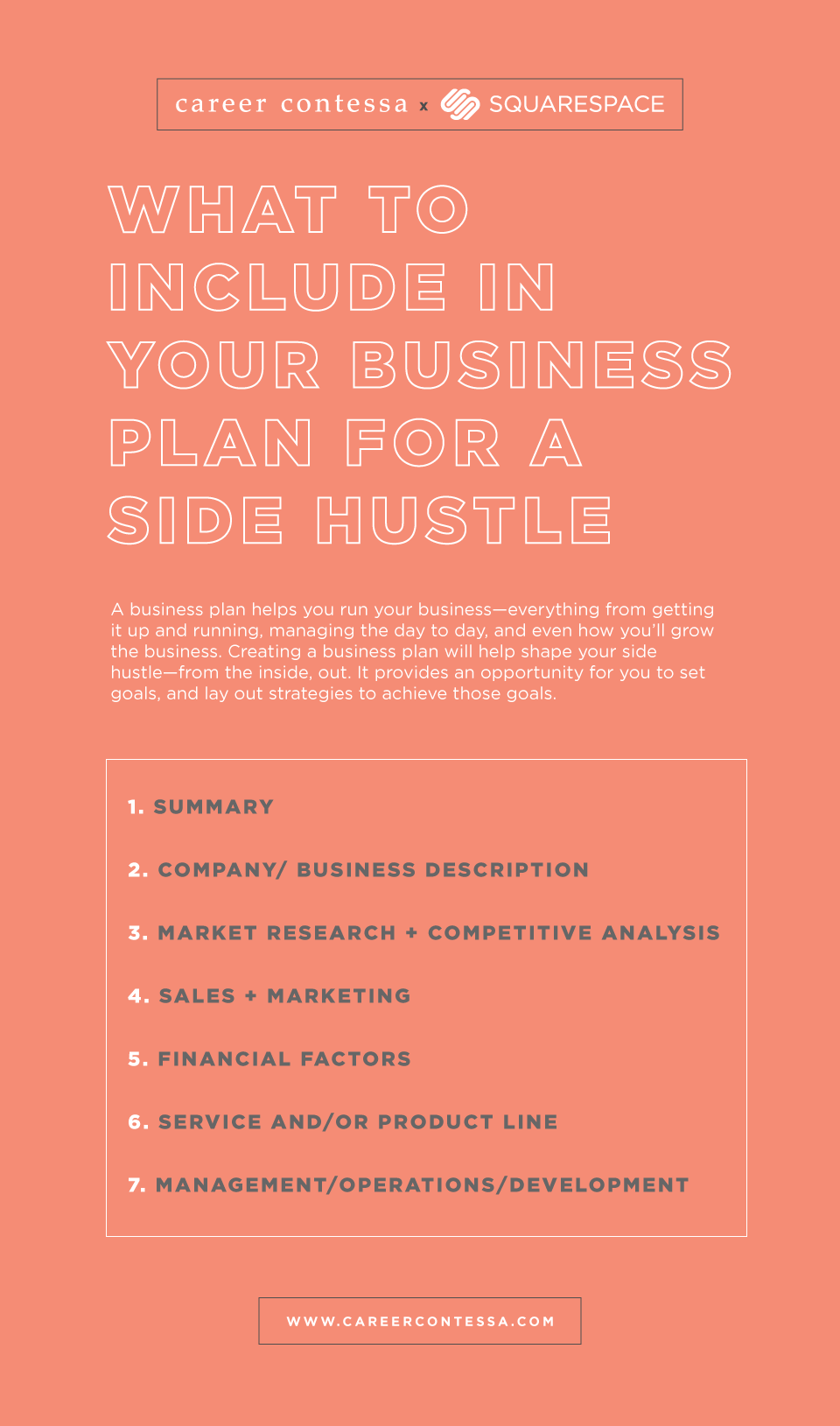This article is sponsored by Squarespace, the website builder that's ideal for starting a side hustle.
Business plans are the foundation of your business. And while the idea of writing one might seem intimidating, I promise it doesn’t have to be.
Simply put, a business plan helps you run your business—everything from getting it up and running, managing the day to day, and even how you’ll grow the business. Creating a business plan will help shape your side hustle—from the inside, out. It provides an opportunity for you to set goals, and lay out strategies to achieve those goals. Even though it requires time up front, I would definitely encourage you to not skip this step when you launch your side-hustle. Having an organized structure will save you lots of time down the road.
Before we dive into what it takes to write a business plan, keep in mind that business plans vary greatly depending on your type of business and your overall future plans—like pitching to investors or self-funding your own side hustle.
To help you kickstart your planning, here are seven sections to include in your business plan:
1. summary
Explain what your company is, the problem you’re solving, unique value proposition, and what type of business you have (i.e. LLC, sole proprietorship, partnership, etc.), along with any mission or value statements you’ve developed. This section is really broad, and is essentially a well-written braindump of what your business is, as well as any specifics that surround it.
In writing your summary for your business plan, you're also laying the foundations for explaining your mission and goals—an essential step in
creating your brand. And when you
build a website for your side hustle, you'll have the copy ready to go for your "About Me" page. One quality summary truly serves endless purposes.
2. Company/Business Description
Your company/business description can start with information about the specific industry and what makes your company/business uniquely qualified to solve a problem/offer a solution to the industry issue. You can mention companies, consumers, or brands you’ll serve and why your company/business will be successful.
Maybe you found the perfect location for a new store, or you can design a product in a way so it lasts longer, or you’ve created a process for something that makes it easier to reproduce quickly without sacrificing quality, etc. Explain what makes your business unique.
3. Market Research + Competitive Analysis
In order to reach your ideal audience, you’ll need to know exactly who they are. I would encourage you to go deep here—what’s their gender, how old are they, where do they shop, what’s their online behavior, level of education, hobbies, family set-up, where do they get their information, and any other information that might help you reach them. You can even create personas with names and descriptions to help you remember that you’re trying to reach real people.
You’ll also want a good understanding of your industry outlook—themes, trends, new data that's changing the industry, what current companies or businesses in a similar space are offering and why. This research will help you be sure your offer is better for the consumer than your competitors'. For example,
Squarespace didn’t invent online websites—but they
did make the process of creating a great looking website without a developer easy, affordable, and timely. Because of their dedication to the consumer, and prioritizing a user-friendly platform, they stand out among their competitors. Because if you really wanted,
you could build a high-quailty, aesthetic, and informative website in just a few hours.
Your goal with competitive analysis is to determine the strengths, weaknesses, and opportunity gaps of the competitors in your market. You’ll also want to consider what barriers you can create to prevent the competition from breaking into your market, and create strategies that will give you a distinct advantage.
4. Sales + Marketing
After you build your amazing product and/or service, you’ll want to consider how you’ll market and sell them to your customers. Will you depend on organic channels like email and social media, paid channels, affiliate marketing, etc. Will you sell directly to consumers or sell wholesale? Will you sell online or in stores? What about shipping fees? If marketing isn't something you're familiar with, don't fret. That's another one of the perks of using a
website builder like Squarespace —they've got
marketing tools built in. Whether you're looking to utilize email
marketing campaigns or boost your organic search results, Squarespace is an all-in-one tool for your side hustle.
For pricing, you’ll want to include (or repeat) what your pricing will be, the justification for it, and any research you’ve collected to prove your customers will pay that amount. If you're thinking, "Yeah, but how do I
actually do that?", don't worry—
we've covered that here.
5. Financial Factors
We can't really talk about side hustles without talking about money. How do you plan to finance your company/business? Consider startup costs, fixed costs, variable costs—and if you’re raising money, how much you need, why, and what it will go toward.
You can also set revenue projections and goals. If you’ve already started earning money for your business, how will you scale that business to bring in more revenue? How will you track your expenses? Be honest and thorough with this section, because
managing cash flow can be one of the most challenging and stressful parts of running a business. Know your numbers forward and backwards—even if you don’t consider yourself a “numbers” person.
6. Service and/or Product Line
This is probably the most fun part of the business plan writing. It's the section where you describe in detail what you will offer, the description of your offer, the price, the delivery, and any other detail you want to include. If you plan to offer many different products or services, include them all in an organized way so you can easily reference them throughout this process.
7. Management/Operations/Development
This last section outlines how your company will be run, who will run it, and how the product will be developed, produced, and function on an ongoing basis. What are the responsibilities of the management team? What’s the budget and timeline for product development? Will the team operate from home or from an office? The company can’t reach its goals without a clear plan on how it will run on a daily basis.
Remember that these suggestions are merely a starting place. If you're really excited about it, you can add additional sections that are tailored to your business. Examples include: ideal client, target audience, funding requests, leadership and advisors, and anything else that helps you better organize your business. Writing a business plan should be exciting! It's the first step in launching what we hope will be a successful and fulfilling project for you, and your career.
From websites and online stores to marketing tools and analytics, Squarespace is the all-in-one platform to build a beautiful online presence and run your business. Use the code CONTESSA when signing up for an account to get 10% off your personal website.










